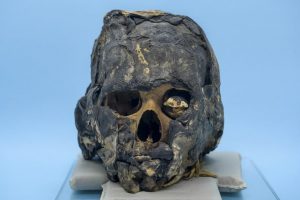Brazilian original research reveals intact cells in mummy
Using tissue processing, the Afro-Egyptian Study Group researchers identified intact cells in the jaw of mummy Iret-Neferet, who is between 2,495 and 2,787 years old. Study will be presented in German congress.

Thais Sousa
tsousa@anba.com.br
São Paulo -The Brazilian team that studies the Egyptian mummy Iret-Neferet has made a breakthrough. Researchers from the Afro-Egyptian Study Group identified, using tissue processing, intact cells in the mummy's jaw. The head of the mummy is a research object of the Afro-Egyptian Identities Study Group at the School of Humanities of the Pontifical Catholic University in Rio Grande do Sul (PUC-RS), which last year managed to identify her age as being between 2,495 and 2,787 years. Picture above, researchers and brothers Edison (left) and Éder Abreu Huttner (right) are standing.
To understand to what extent the Egyptian ancient technique of mummification could have kept the body tissue preserved, the group analyzed part of the mummy's jaw medullary bone and masseter muscle. The material was processed and went through a histological analysis in the Pathological Anatomy Lab of the Hospital São Lucas of PUC-RS. Under the microscope, they found intact connective tissue structures, identifying red cells within the blood vessel and bone trabeculae of the jaw with preserved morphology.
The oral and maxillofacial surgeon and gerontologist dr. Éder Abreu Hüttner, a member of the group, explained that to identify the mummy's age using radiocarbon (C14) dating, the team had used extracted teeth. "I extracted a tooth of the mummy, and we proved her age. Then, we kept studying it. In the beginning of the year, we did a study to see the characteristic of the cell. Using a tissue processing technique, we identified that the cell had its tissue morphology preserved, Hüttner told ANBA.

Study identified intact cells in 2,000-year-old mummy
The tissue process was done in 15 days, and the team will present the study remotely on Saturday (10) in the European Association for Osseointegration (AEO) Congress based in Berlin, Germany, one of the world's most relevant odontology congresses.
One of the major achievements of the discovery is the efficacy of the mummification process in conserving the human tissue. "What's important is noting the Egyptian technology in tissue preservation. This shows the Egyptians had techniques, and their technology managed to keep a cell intact for 2,500 years," Hüttner stressed.

The 1 shows the red cells within the blood vessel. The 2, the bone trabeculae.
The doctor pointed out this discovery is a first in Brazil, but there are records of other mummies that could have intact cells, too. Therefore, the researchers' next step is signing a partnership with the Max Planck Institute in Germany, which specializes in DNA studies. "These new cells allow for a DNA assessment. And this institute has a DNA bank, where we could even identify some relative of Iret-Neferet," he explained, adding that they are now working to establish a technical cooperation with the German institution.
In addition to tissue preservation, the group researches other traits found in the mummy that allow for a range of analysis. The study is called gene-environment. "The wealth of information from the DNA is huge. From then, we will carry out a genome of the mummy, a gene-environment analyses to better understand how she lived. For example, we've identified she have many cavities, and the time she lived was when the starch was first introduced in Egypt. The higher classes were the ones to have access to this food and, therefore, more cavities. She also shows a dental wear, suggesting bruxism. Thus, we wonder, how was the stress back then?" he said.
Translated by Guilherme Miranda
-- Sent from my Linux system.
No comments:
Post a Comment